Performance Analysis of a Rooftop Grid-Connected Photovoltaic System in North-Eastern India, Manipur
Abstract
1. Introduction
2. PV System Description
3. Technical Performance Parameters of the PV Systems and PVsyst Configuration for Simulation
4. Results and Discussions
4.1. Metrological Site
- (a)
- GHI ranged from 3.68 (June 2022) to 5.78 kW/m2/day (April 2023).
- (b)
- DHI ranged from 1.28 (December 20220) to 3.19 kW/m2/day (July 2018).
- (c)
- Ambient temperature ranged from 12.85 °C (January 2020) to 24.82 °C (June 2023).
- (d)
- Clearness index ranged from 0.33 (June 2022) to 0.68 (January 2019).
4.2. Energy Variation Analysis
4.3. Performance Analysis
4.4. Actual Economic Analysis
- Capital Cost = Rs 600,000/-.
- Subsidy (70% of the capital cost) = Rs 420,000/-.
- Actual cost = Capital Cost − Subsidy = Rs 180,000/-.
- Selling price per unit kWh = Rs 3.16/-.
- From Figure 13, it can be seen that at the end of 4 years and 10 months, the generation of energy reaches 57,449.2 kWh.
- Recovery amount at the end of 4 years and 10 months = Eg × Selling price per unit kWh = 57,449.2 × 3.16 =Rs 181,539.47/-
5. Conclusions
Author Contributions
Funding
Data Availability Statement
Conflicts of Interest
Abbreviations
| PV | Photovoltaic |
| GHI | Global horizontal irradiance (kW/m2/day). |
| DHI | Diffuse horizontal irradiance (kW/m2/day). |
| PR | Performance ratio (%). |
| CUF | Capacity utilization factor (%). |
| ηsys | System efficiency (%). |
| Final yield (kWh/kWp). | |
| Reference yield (kWh/kWp). | |
| YA | Array yield (kWh/kWp). |
| Capture loss (kWh/kWp). | |
| System loss (kWh/kWp). | |
| ISC | Short-circuit current (A). |
| VOC | Open-circuit voltage (V). |
| Vmp | Voltage at maximum power point (V). |
| Imp | Current at maximum power point (A). |
| Gi | Total in-plane irradiance. |
| GSTC | Solar irradiation under STC. |
| EAC, d | Daily energy to the grid. |
| EDC, d | Daily PV array output. |
| PPVrated | PV array capacity. |
| Aa | PV array area. |
| YF, a | Annual final yield. |
| STC | Standard test condition. |
| A_Y(Pre) | Predicted energy produced by the array. |
| A_Y(Mea) | Measured energy produced by the array. |
| F_Y(Pre) | Predicted energy fed to the grid. |
| F_Y(Mea) | Measured energy fed to the grid. |
| R_Y(Mea) | Measure reference yield. |
References
- Li, C. Economic and performance evaluation of grid-connected residential solar photovoltaic systems in Northwest China. Energy Sources Part A Recovery Util. Environ. Eff. 2022, 44, 5473–5489. [Google Scholar] [CrossRef]
- Teyabeen, A.A.; Algareu, A.; Mohamed, F. Assessment of Solar Photovoltaic System Performance. In Proceedings of the 2023 14th International Renewable Energy Congress (IREC), IEEE, Sousse, Tunisia, 16–18 December 2023; pp. 1–5. [Google Scholar]
- Liu, J. China's renewable energy law and policy: A critical review. Renew. Sustain. Energy Rev. 2019, 99, 212–219. [Google Scholar] [CrossRef]
- Kamble, A.D.; Das, S.; Vijaya; Das, B.; Bordoloi, U.; Hazarika, P.; Kalita, P. Role of Solar Energy in the Development of the Indian Economy. In Challenges and Opportunities of Distributed Renewable Power; Springer Nature: Singapore, 2024; pp. 489–535. [Google Scholar]
- Dhiman, B.; Zindani, D.; Chakrabarti, D.; Singh, G. A user-centric assessment of solar-photovoltaic-home-lighting systems in rural parts of Assam, India. Energy Sustain. Dev. 2023, 76, 101290. [Google Scholar] [CrossRef]
- Das, D.; Saikia, S.; Saharia, S.J.; Mahapatra, S. Performance analysis of MW-scale grid connected rooftop and ground-mounted solar power plants installed in Assam, India. Energy Sustain. Dev. 2023, 76, 101309. [Google Scholar] [CrossRef]
- Tajjour, S.; Chandel, S.S.; Chandel, R.; Thakur, N. Power generation enhancement analysis of a 400 kWp grid-connected rooftop photovoltaic power plant in the hilly terrain of India. Energy Sustain. Dev. 2023, 77, 101333. [Google Scholar] [CrossRef]
- Aktas, I.S.; Ozenc, S. A case study of techno-economic and environmental analysis of college rooftop for grid-connected PV power generation: Net zero 2050 pathway. Case Stud. Therm. Eng. 2024, 56, 10427. [Google Scholar] [CrossRef]
- Mohamed, K.; Shareef, H.; Nizam, I.; Esan, A.B.; Shareef, A. Operational Performance Assessment of Rooftop PV Systems in the Maldives. Energy Rep. 2024, 11, 2592–2607. [Google Scholar] [CrossRef]
- Attari, K.; Elyaakoubi, A.; Asselman, A. Performance analysis and investigation of a grid-connected photovoltaic installation in Morocco. Energy Rep. 2016, 2, 261–266. [Google Scholar] [CrossRef]
- de Lima, L.C.; de Araújo Ferreira, L.; de Lima Morais, F.H. Performance analysis of a grid-connected photovoltaic system in northeastern Brazil. Energy Sustain. Dev. 2017, 37, 79–85. [Google Scholar] [CrossRef]
- Sharma, V.; Chandel, S.S. Performance analysis of a 190 kWp grid interactive solar photovoltaic power plant in India. Energy 2013, 55, 476–485. [Google Scholar] [CrossRef]
- Aryal, A.; Bhattarai, N. Modeling and simulation of 115.2 kWp grid-connected solar PV system using PVSYST. Kathford J. Eng. Manag. 2018, 1, 31–34. [Google Scholar] [CrossRef]
- Arora, R.; Arora, R.; Sridhara, S.N. Performance assessment of 186 kWp grid interactive solar photovoltaic plant in Northern India. Int. J. Ambient Energy 2022, 43, 128–141. [Google Scholar] [CrossRef]
- Ramanan, P.; Karthick, A. Performance analysis and energy metrics of grid-connected photovoltaic systems. Energy Sustain. Dev. 2019, 52, 104–115. [Google Scholar]
- Ramanan, P.; Kalidasa Murugavel, K.; Karthick, A.; Sudhakar, K. Performance evaluation of building-integrated photovoltaic systems for residential buildings in southern India. Build. Serv. Eng. Res. Technol. 2020, 41, 492–506. [Google Scholar] [CrossRef]
- Kumar, M.; Chandel, S.S.; Kumar, A. Performance analysis of a 10 MWp utility scale grid-connected canal-top photovoltaic power plant under Indian climatic conditions. Energy 2020, 204, 117903. [Google Scholar] [CrossRef]
- Dahbi, H.; Aoun, N.; Sellam, M. Performance analysis and investigation of a 6 MW grid-connected ground-based PV plant installed in hot desert climate conditions. Int. J. Energy Environ. Eng. 2021, 12, 577–587. [Google Scholar] [CrossRef]
- Navothna, B.; Thotakura, S. Analysis on large-scale solar PV plant energy performance–loss–degradation in coastal climates of India. Front. Energy Res. 2022, 10, 857948. [Google Scholar] [CrossRef]
- Minai, A.F.; Usmani, T.; Alotaibi, M.A.; Malik, H.; Nassar, M.E. Performance analysis and comparative study of a 467.2 kWp grid-interactive SPV system: A case study. Energies 2022, 15, 1107. [Google Scholar] [CrossRef]
- Besheer, A.H.; Eldreny, M.A.; Rashad, H.; Bahgat, A. Status monitoring and performance investigation of a 5.1 kW rooftop grid-tie photovoltaic energy system. In Modern Maximum Power Point Tracking Techniques for Photovoltaic Energy Systems; Springer: Cham, Switzerland, 2019; pp. 463–486. [Google Scholar]
- Sharma, V.; Kumar, A.; Sastry, O.S.; Chandel, S.S. Performance assessment of different solar photovoltaic technologies under similar outdoor conditions. Energy 2013, 58, 511–518. [Google Scholar] [CrossRef]
- Ayompe, L.M.; Duffy, A.; McCormack, S.J.; Conlon, M. Measured performance of a 1.72 kW rooftop grid-connected photovoltaic system in Ireland. Energy Convers. Manag. 2011, 52, 816–825. [Google Scholar] [CrossRef]
- Okello, D.; Van Dyk, E.E.; Vorster, F.J. Analysis of measured and simulated performance data of a 3.2 kWp grid-connected PV system in Port Elizabeth, South Africa. Energy Convers. Manag. 2015, 100, 10–15. [Google Scholar] [CrossRef]
- Kumar, K.A.; Sundareswaran, K.; Venkateswaran, P.R. Performance study on a grid connected 20 kWp solar photovoltaic installation in an industry in Tiruchirappalli (India). Energy Sustain. Dev. 2014, 23, 294–304. [Google Scholar] [CrossRef]
- Yadav, S.K.; Bajpai, U. Performance evaluation of a rooftop solar photovoltaic power plant in Northern India. Energy Sustain. Dev. 2018, 43, 130–138. [Google Scholar] [CrossRef]
- Vasisht, M.S.; Srinivasan, J.; Ramasesha, S.K. Performance of solar photovoltaic installations: Effect of seasonal variations. Sol. Energy 2016, 131, 39–46. [Google Scholar] [CrossRef]
- Sharma, R.; Goel, S. Performance analysis of a 11.2 kWp roof top grid-connected PV system in Eastern India. Energy Rep. 2017, 3, 76–84. [Google Scholar] [CrossRef]
- Vasudev, K.P.; Mathew, M.; Anand, A.; Hossain, J. Performance Analysis of a 48 kWp Grid connected Rooftop Photovoltaic System. In Proceedings of the 2018 4th International Conference for Convergence in Technology (I2CT), IEEE, Mangalore, India, 27–28 October 2018; pp. 1–6. [Google Scholar]
- Sundaram, S.; Babu, J.S. Performance evaluation and validation of 5 MWp grid connected solar photovoltaic plant in South India. Energy Convers. Manag. 2015, 100, 429–439. [Google Scholar] [CrossRef]
- Kebede, A.A.; Berecibar, M.; Coosemans, T.; Messagie, M.; Jemal, T.; Behabtu, H.A.; Van Mierlo, J. A techno-economic optimization and performance assessment of a 10 kWP photovoltaic grid-connected system. Sustainability 2020, 12, 7648. [Google Scholar] [CrossRef]
- Mondol, J.D.; Yohanis, Y.; Smyth, M.; Norton, B. Long term performance analysis of a grid connected photovoltaic system in Northern Ireland. Energy Convers. Manag. 2006, 47, 2925–2947. [Google Scholar] [CrossRef]
- Pundir, K.S.; Varshney, N.; Singh, G.K. Comparative study of performance of grid connected solar photovoltaic power system in IIT Roorkee campus. Int. J. Innov. Res. Sci. Eng. 2016, 2, 319–422. [Google Scholar]
- Emmanuel, M.; Akinyele, D.; Rayudu, R. Techno-economic analysis of a 10ákWp utility interactive photovoltaic system at Maungaraki school, Wellington, New Zealand. Energy 2017, 120, 573–583. [Google Scholar] [CrossRef]
- Padmavathi, K.; Daniel, S.A. Performance analysis of a 3 MWp grid connected solar photovoltaic power plant in India. Energy Sustain. Dev. 2013, 17, 615–625. [Google Scholar] [CrossRef]
- Kalita, P.; Das, S.; Das, D.; Borgohain, P.; Dewan, A.; Banik, R.K. Feasibility study of installation of MW level grid connected solar photovoltaic power plant for northeastern region of India. Sādhanā 2019, 44, 207. [Google Scholar] [CrossRef]
- Barman, M.; Mahapatra, S.; Palit, D.; Chaudhury, M.K. Performance and impact evaluation of solar home lighting systems on the rural livelihood in Assam, India. Energy Sustain. Dev. 2017, 38, 10–20. [Google Scholar] [CrossRef]
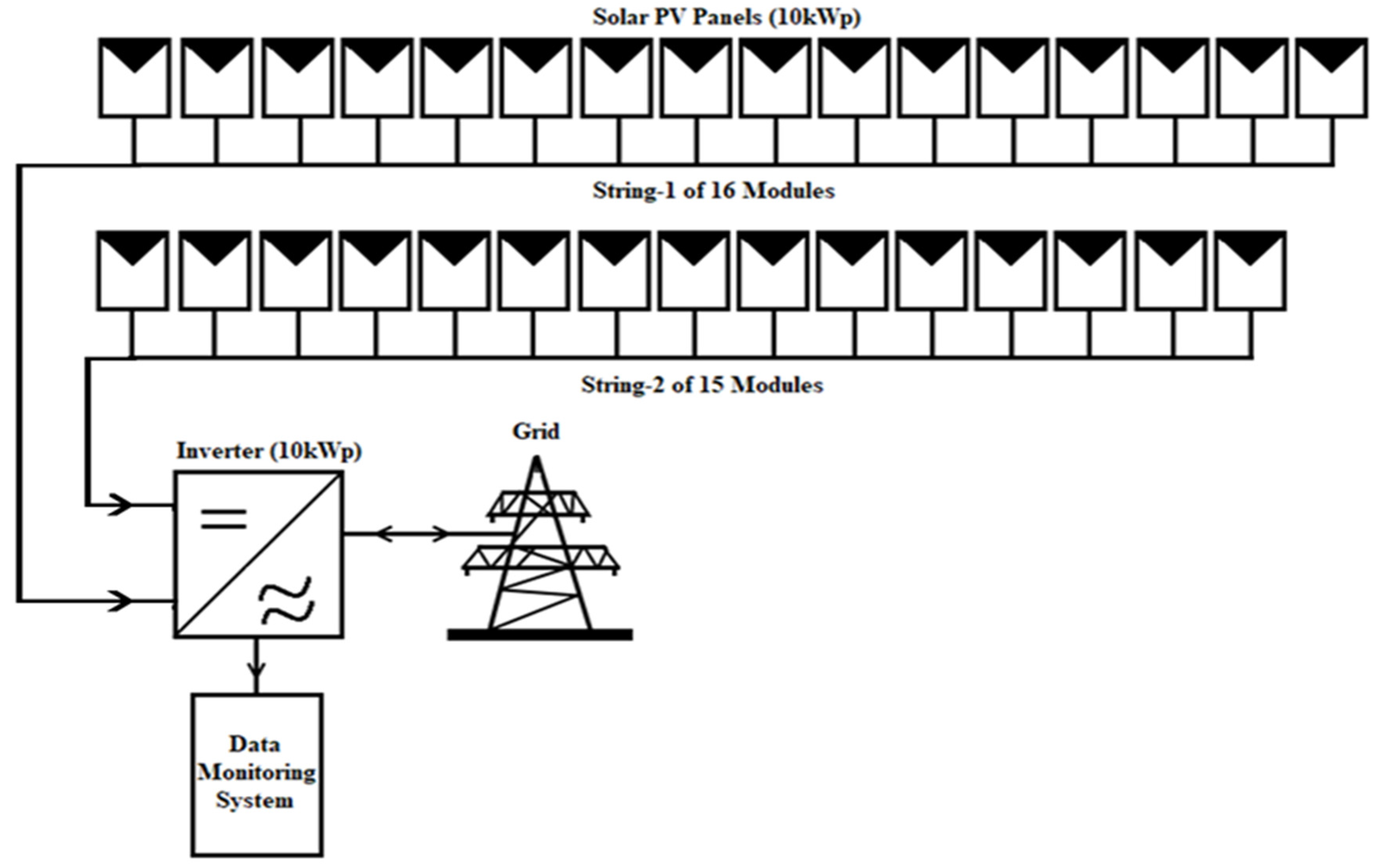
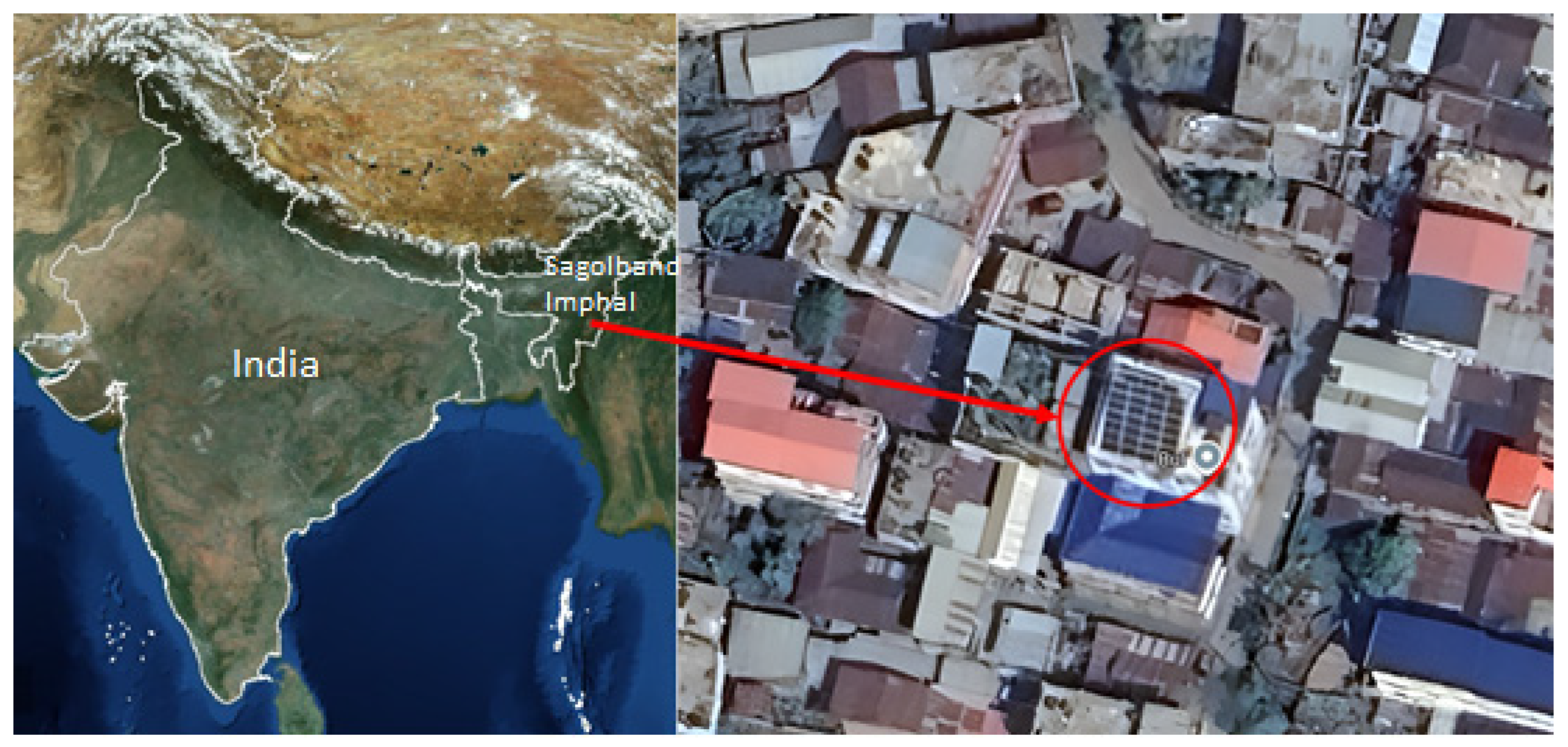
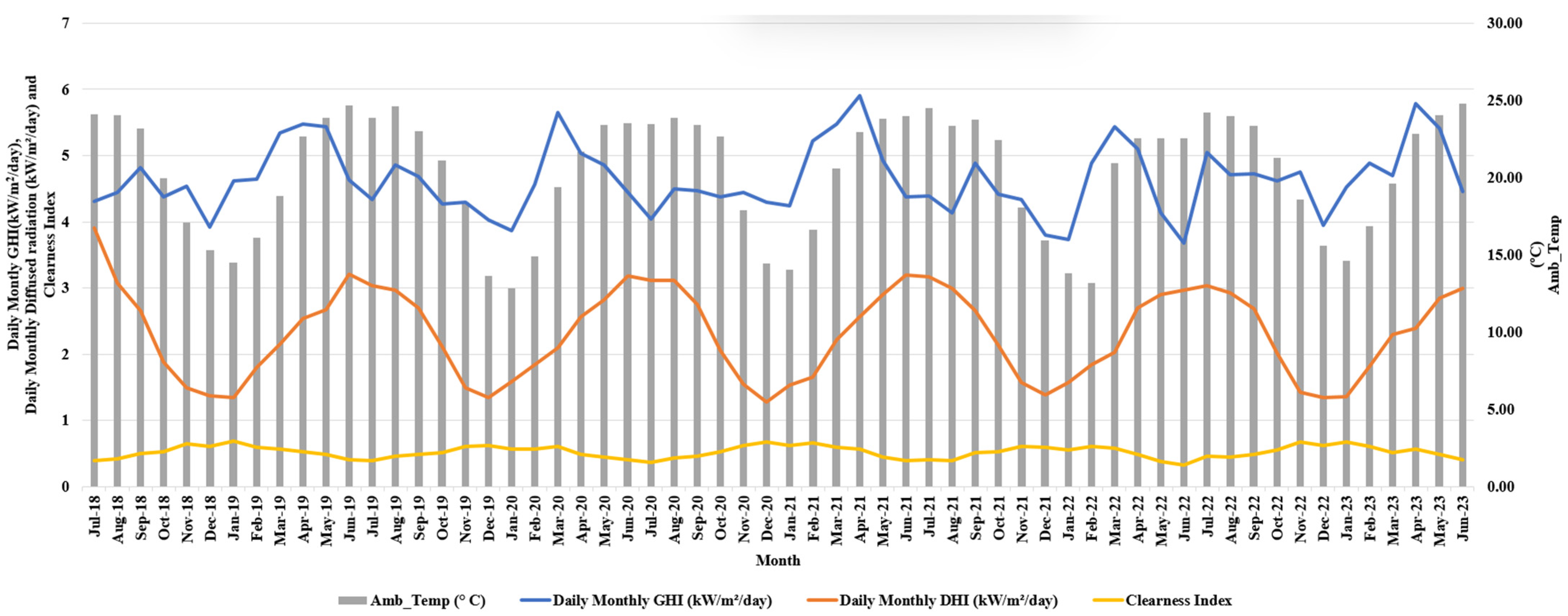

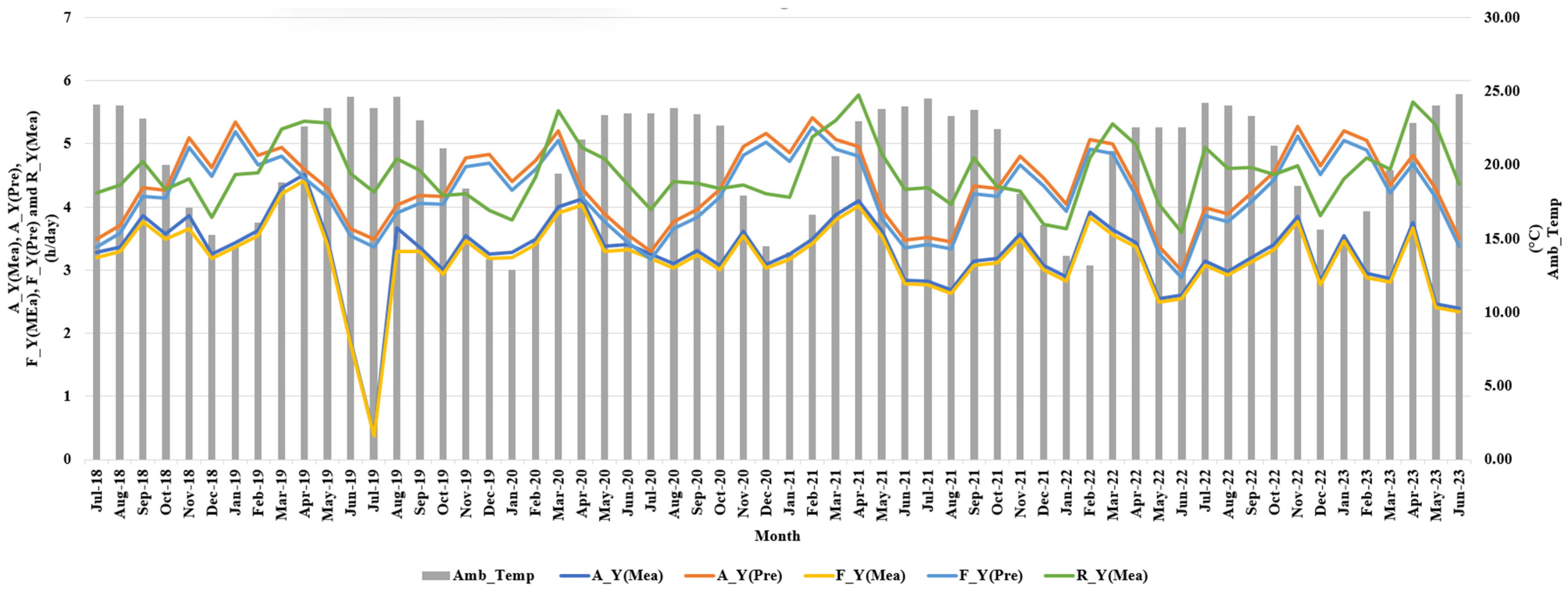
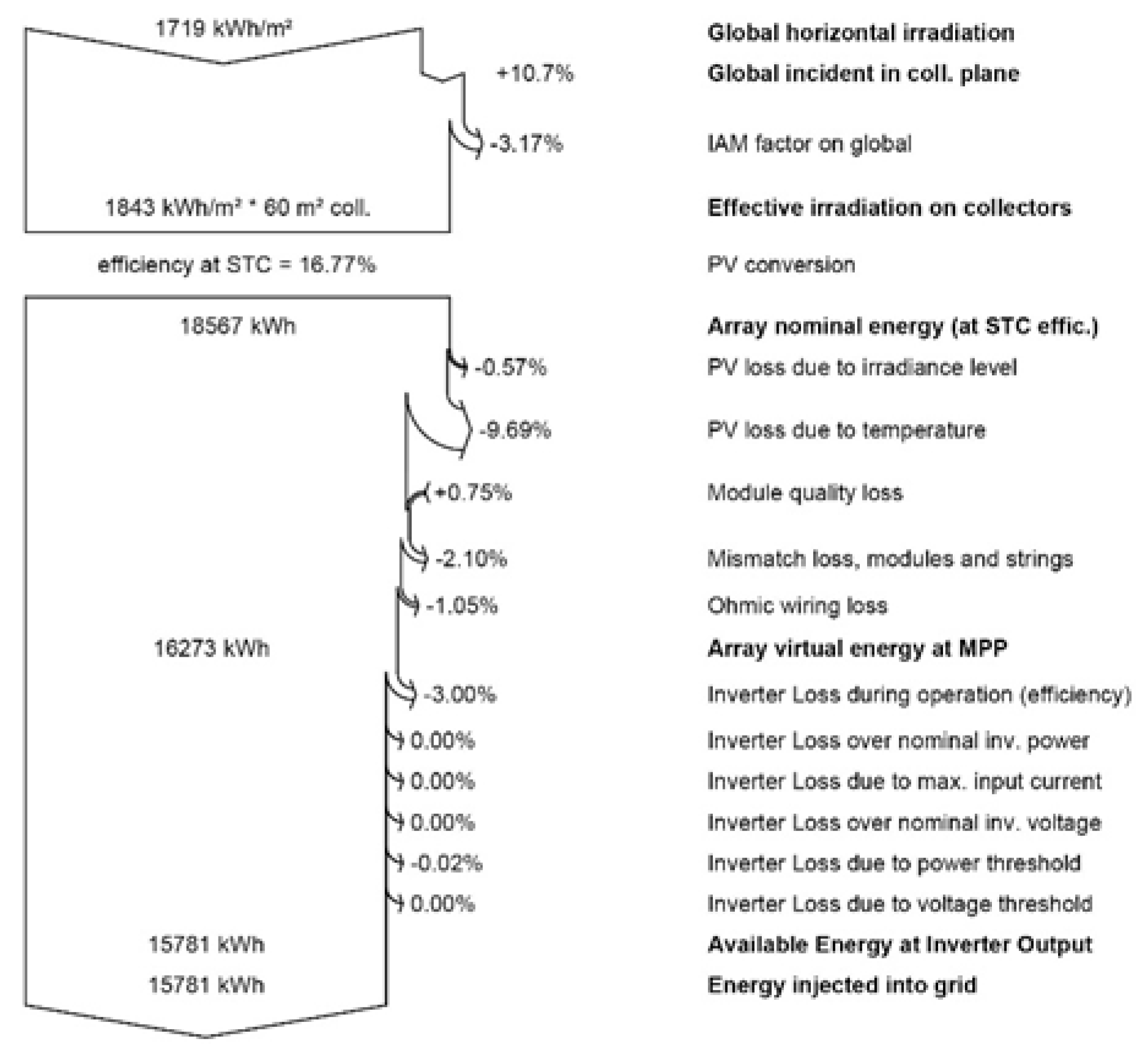
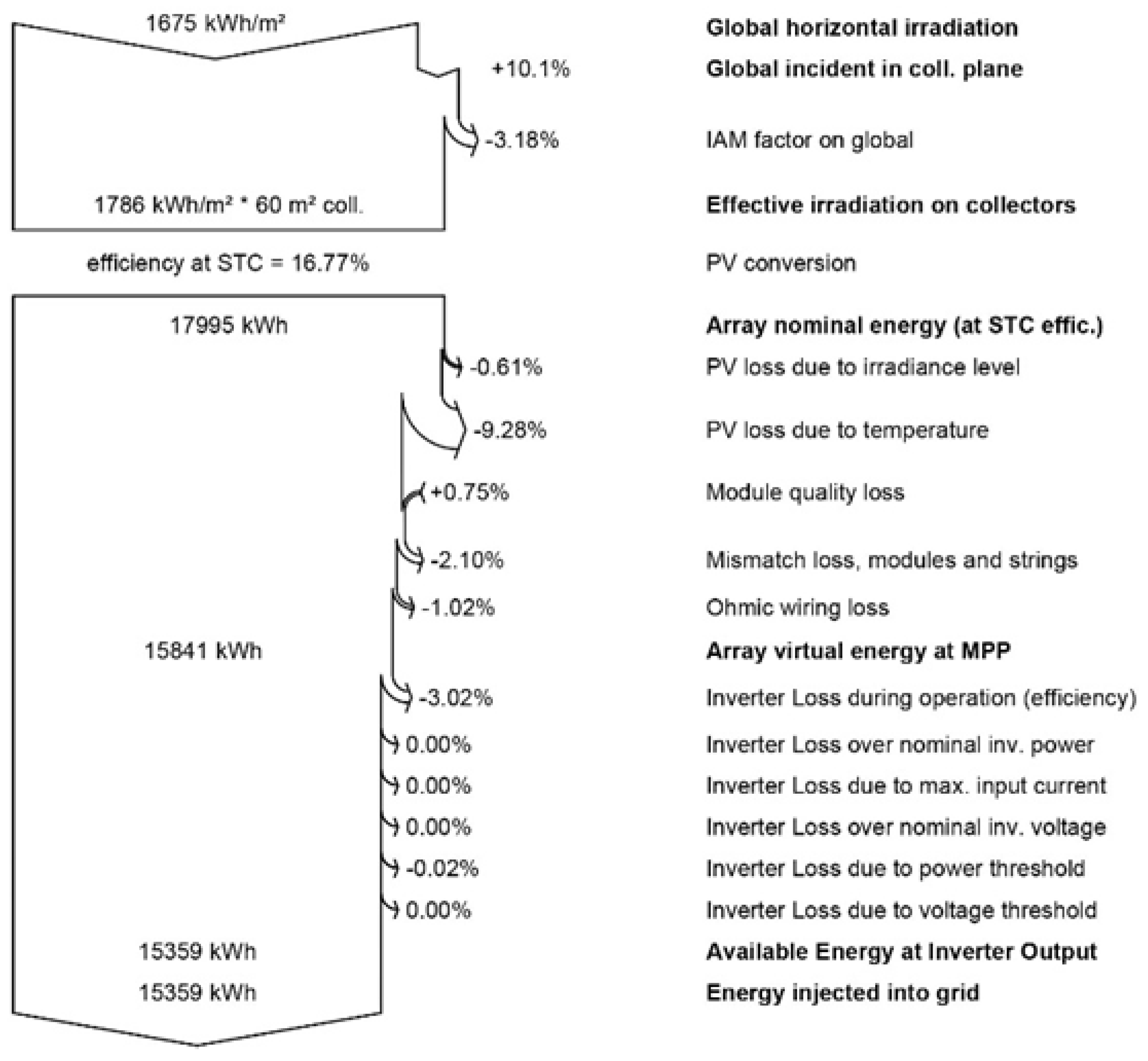
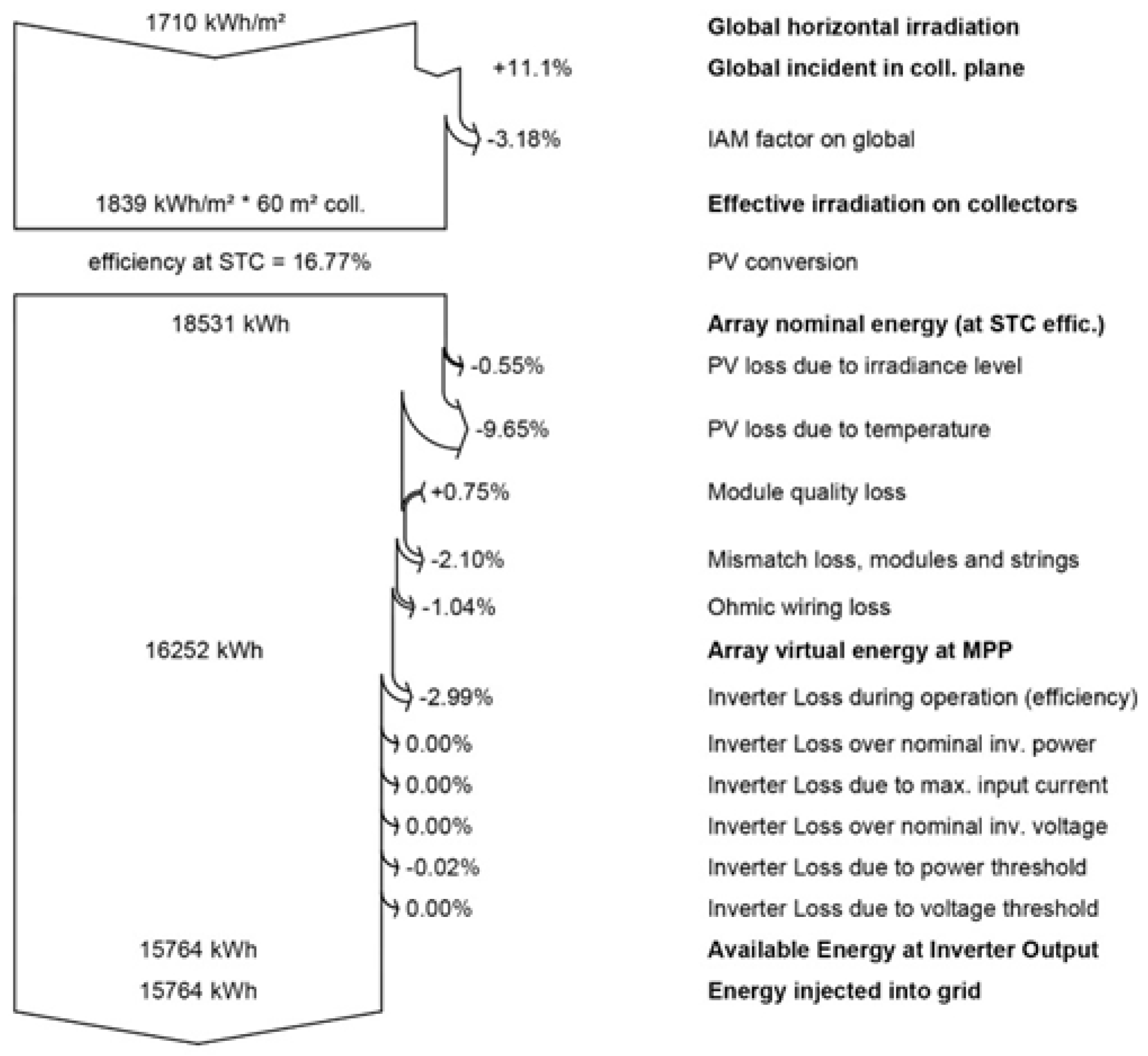
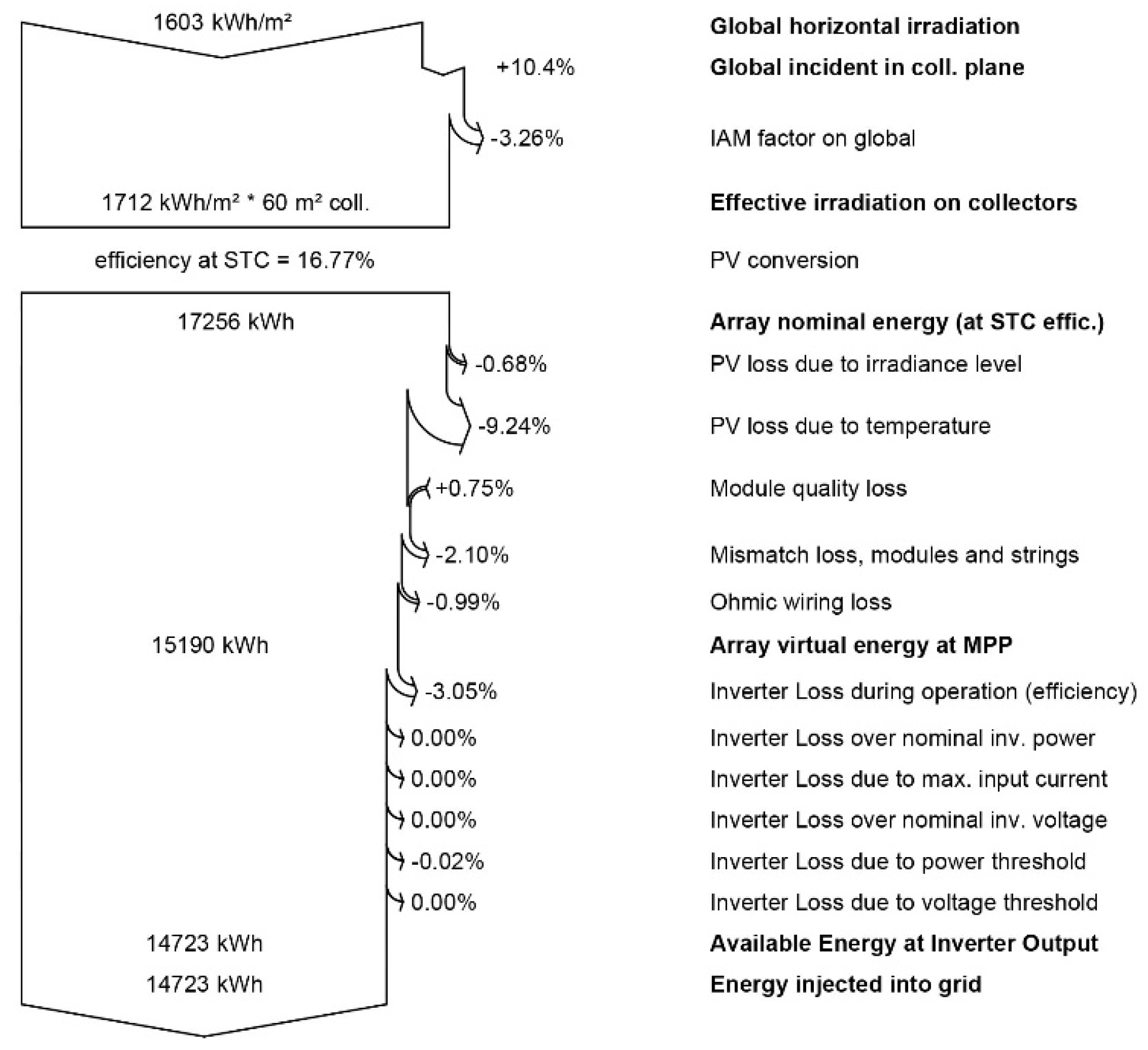
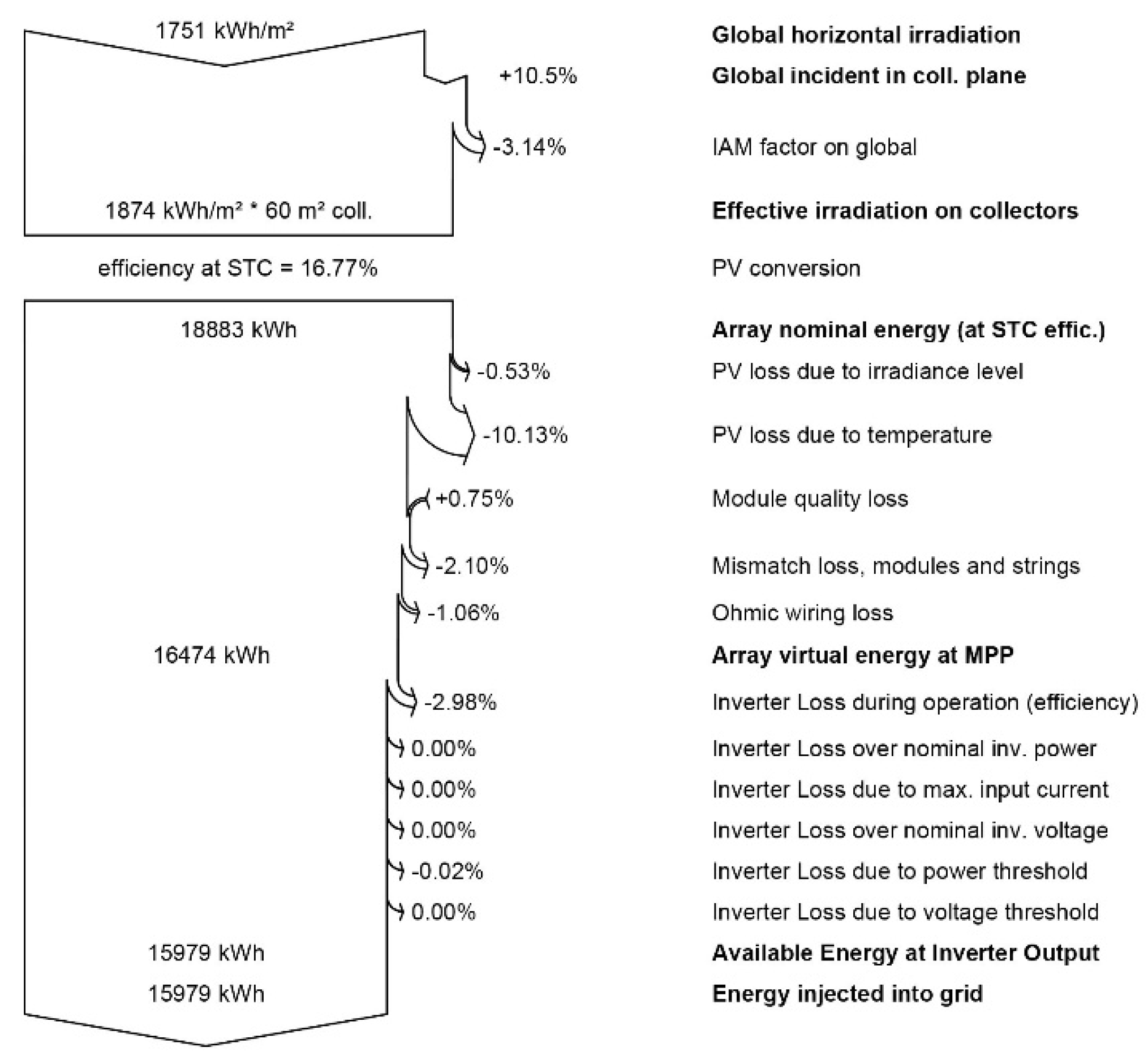
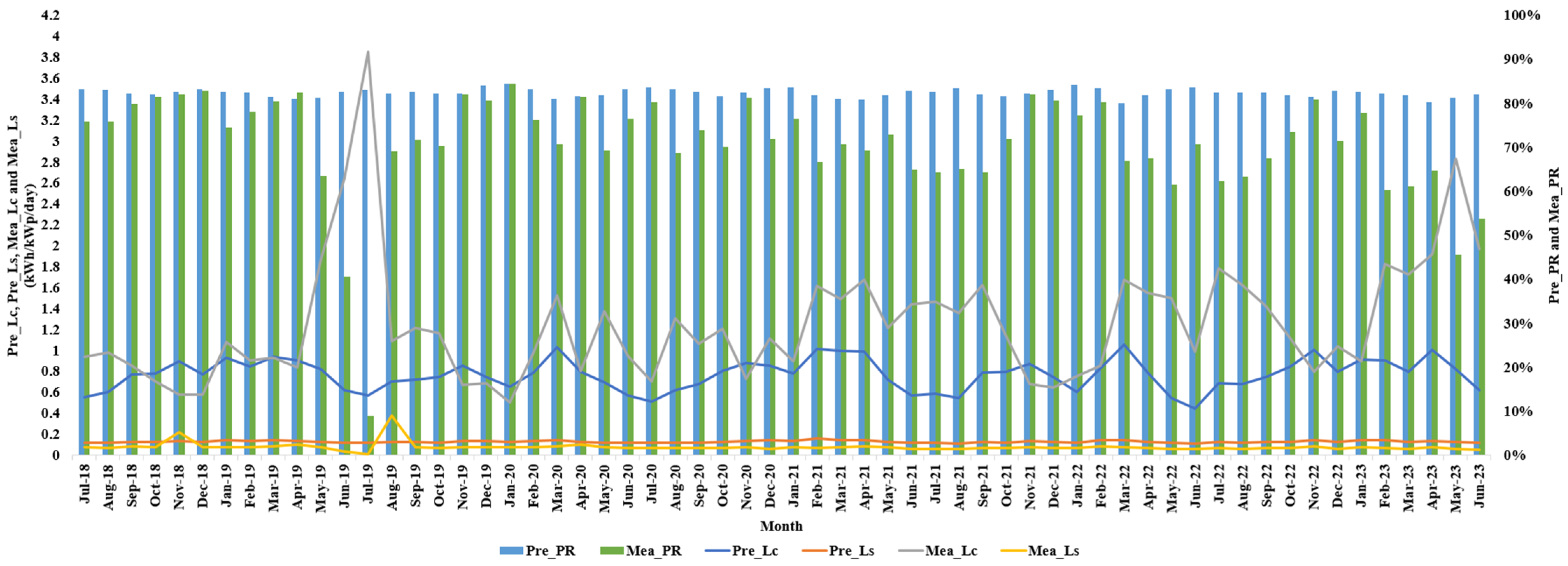
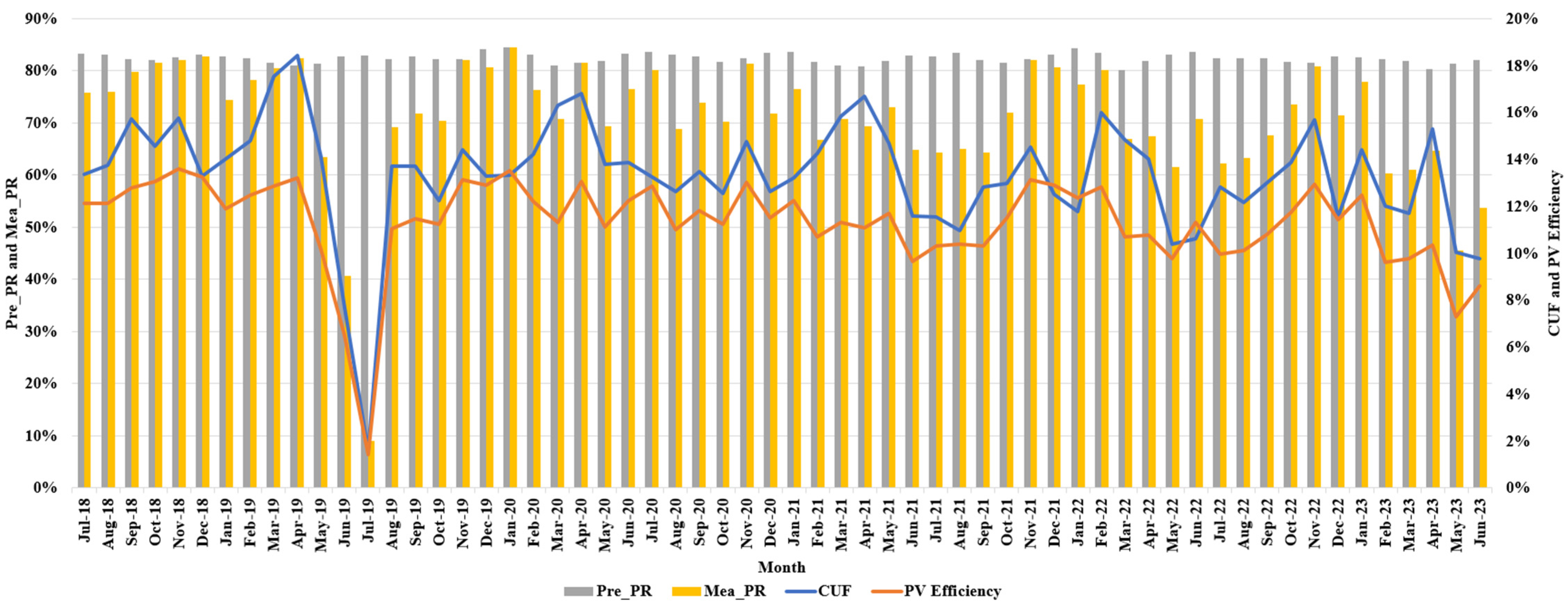
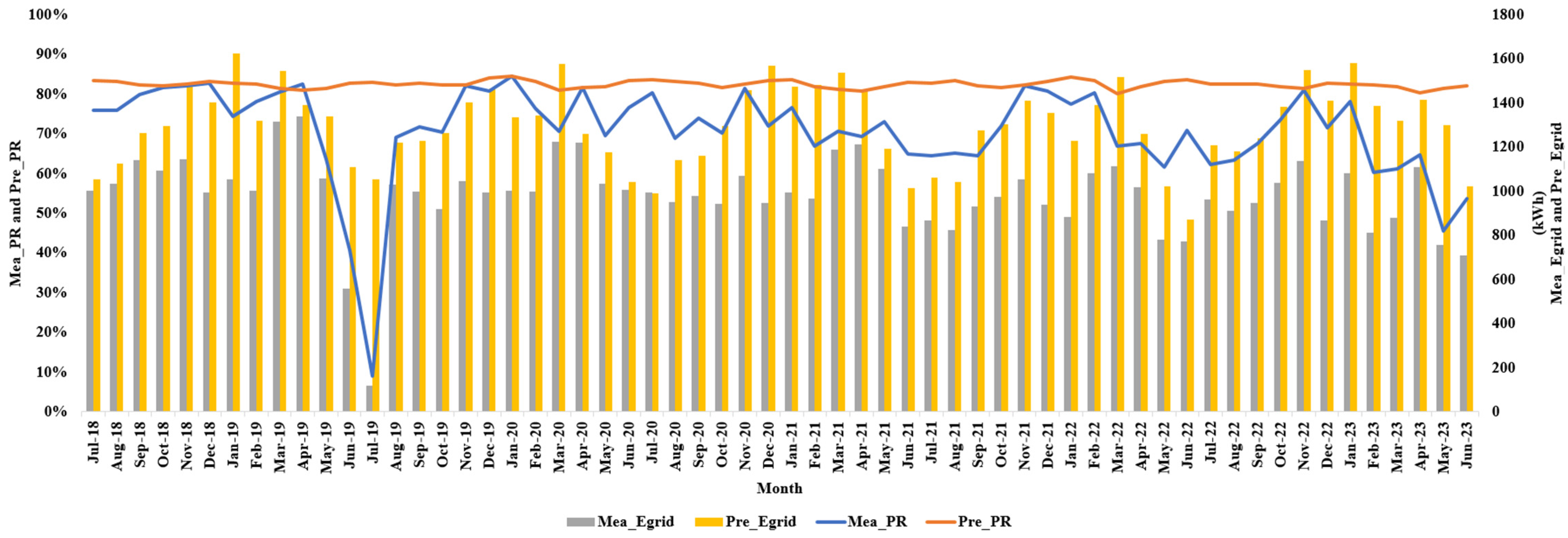
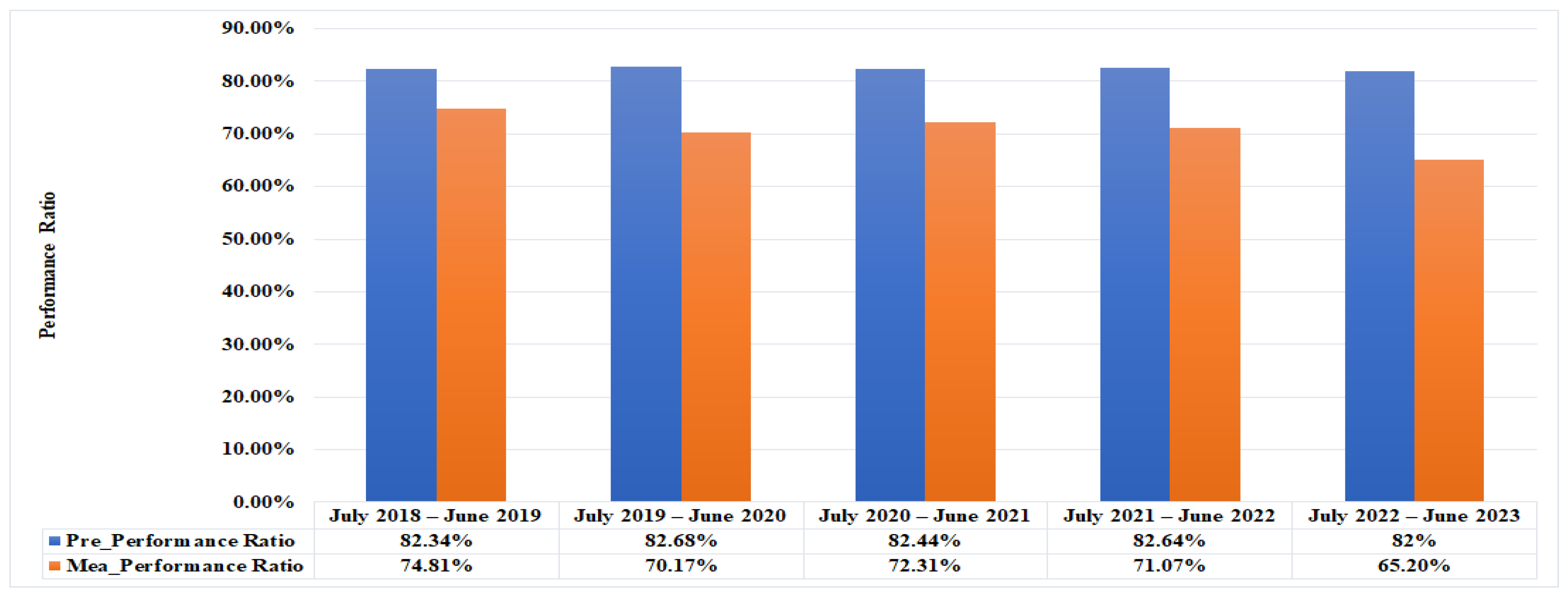
| Site | State, Country | Latitude at the Site | Longitude at the Site | Inclination of the Panel | Region |
|---|---|---|---|---|---|
| Sagolband, Imphal | Manipur, India | +24.804° N | +93.926° E | 22° | North-eastern part of India |
| System | Manufacturer and Name | Specifications |
|---|---|---|
| PV Panel | Alpex company (Greater Noida, India) (ALP325W) | Type of modules = poly-crystalline, PoweRated (PR) = 325 Wp, Vmp = 37.67 V, Imp = 8.63 A, VOC = 45.41 V, ISC = 9.34 A, efficiency (ηp) = 16.34%, no. of modules = 31, no. of module string = 2, module tilt = 22°, area of each panel (Ap) = 1.99 m2 |
| Inverter | ABB (Zürich, Switzerland) (PVI-10.0-TL-OUTD 10 kW) | Three-phase string inverter, 10 kWac, 2MPPT, RS-485 communication interface. Rated DC input power (Vdcr) = 10.3 kW, maximum DC input power for each MPPT = 6500 W, maximum DC input current for each MPPT = 17 A, rated AC output power = 10 kW, rated AC grid voltage = 400 V, rated efficiency = 97%, communication interface was WLAN |
| Sl. No. | References | Performance Indices | Definitions | Expression | Equation No. |
|---|---|---|---|---|---|
| 1. | [22] | Reference yield () | Total in-plane irradiance, divided by solar radiation under standard test conditions. | (1) | |
| 2. | [23] | Array Yield (YA) | Energy produced by the array. | (2) | |
| 3. | [23] | Final Yield ( | Energy fed to the grid. | (3) | |
| 4. | [24] | System efficiency | Input GHI to energy fed to the grid. | (4) | |
| 5. | [25] | Performance ratio (PR) | Energy generated to grid with regard to installed capacity of PV system. | (5) | |
| 6. | [26] | Capture loss ( | Loss in PV panel in conversion from GHI to electricity. | (6) | |
| 7. | [26] | System loss ( | Losses due to inverter and wiring material | (7) | |
| 8. | [27] | Capacity utilization factor (CUF) | The PV plant’s actual energy production for an entire year, 24 h a day, compared to the maximum energy generation of rated power during that time. | (8) |
| Parameters | July 2018–June 2019 | July 2019–June 2020 | July 2020–June 2021 | July 2021–June 2022 | July 2022–June 2023 |
|---|---|---|---|---|---|
| GHI (kW/m2/day) | April 19—5.47 (Max) Dec 18—3.92 (Min) | March 20—5.65 (Max) Jan 20—3.87 (Min) | April 21—5.9 (Max) Jul 20—4.04 (Min) | March 22—5.43 (Max) Jun 22—3.68 (Min) | April 23—5.79 (Max) Dec 22—3.95 (Min) |
| DHI (kW/m2/day) | Jul 18—3.91 (Max) Jan 19—1.34 (Min) | Jun 20—3.18 (Max) Dec 19—1.35 (Min) | Jun 21—3.19 (Max) Dec 20—1.28 (Min) | Jul 21—3.17 (Max) Dec 21—1.39 (Min) | Jul 22—3.03 (Max) Dec 22—1.35 (Min) |
| Amb_temp (°C) | Jun 19—24.65 (Max) Jan 19—14.49 (Min) | Aug 19—24.61 (Max) Jan 20—12.85 (Min) | Jun 21—24 (Max) Jan 21—14.06 (Min) | Jul 21—24.52 (Max) Feb 22 13.18 (Min) | Jun 23—24.82 (Max) Jan 23—14.59 (MIN) |
| Clearness Index | Jan 19—0.68 (Max) July 18—0.39 (Min) | Dec 19—0.62 (Max) Jul 19—0.39 (Min) | Dec 20—0.67 (Max) Jul 20—0.37 (Min) | Nov 21, Feb 22—0.61 (Max) Jun 22—0.33 (Min) | Nov 22, Jan 23—0.67 (Max) Jun 23—0.40 (Min) |
| Location | Panel Type | Capacity (KWp) | Monitoring Period (Year) | Annual AC Generation (MWh) | Final Yield (h/day) | PV Efficiency (%) | CUF | PR (%) | References |
|---|---|---|---|---|---|---|---|---|---|
| Bhubaneswar, India | P-Si | 11.2 | 1 | 14.96 | 3.67 | 1 × 3.42 | 15.27 | 78 | [28] |
| Vasant Kunj, New Delhi | PC | 48 | 1 | 59.58 | 3.14 | 11.95 | 13.9 | 80 | [29] |
| Bhel, Tiruchirappalli, Tamil Nadu | p-Si | 20 | 1 | 30.14 | - | - | 17.2 | 82 | [25] |
| Integral University, Lucknow | p-Si | 467.2 | 3 | 1911.5 | - | 15.47 | 15.25 | 80.86 | [20] |
| Khatkar-Kalan, India | p-Si | 190 | 1 | 154.42 | 2.33 | 8.3 | 9.27 | 74 | [12] |
| Thuvakudi, Tiruchirappalli, India | MC-Si A-SI PC-Si | 5 | 1 | 8495.3 | 4.81 | 5.08 | - | 89 | [30] |
| Bahir Dar, Ethiopia | Mono-Crystalline | 10 | 1 | 11.81 | 2.02–3.45 | 9.3–10.7 | - | 64.74 | [31] |
| Dublin, Ireland | Mc-Si | 13 | 3 | - | 1.69 | 6.4 | - | 60–62 | [32] |
| IIT, Roorkee, India | P-Si | 1816 | 1 | 2.203 | 3.32 | 8.7 | 13.85 | 63.68 | [33] |
| University of Lucknow, India | - | 5 | 1 | 7.175 | 3.99 | 10.02 | 16.39 | 76.97 | [26] |
| Wellington, New Zealand | Monocrystalline | 10 | 1 | - | 2.99 | 11.96 | 12.5 | 78 | [34] |
| Amity University, Haryana, India | Multi-Crystallin | 186 | 1 | 289.391 | 4.28 | 13.76 | 17.8 | 82.7 | [13] |
| Karnataka, India | Mono-crystallin | 3000 | 1 | 4204 | 3.75 | 12.3 | 20 | 70 | [35] |
| Sagolband, Imphal, Manipur, India | P-Si | 10 | 5 | 58.911 | 3.20 | 11.31 | 13.36 | 70.71 | Present Study |
Disclaimer/Publisher’s Note: The statements, opinions and data contained in all publications are solely those of the individual author(s) and contributor(s) and not of MDPI and/or the editor(s). MDPI and/or the editor(s) disclaim responsibility for any injury to people or property resulting from any ideas, methods, instructions or products referred to in the content. |
© 2025 by the authors. Licensee MDPI, Basel, Switzerland. This article is an open access article distributed under the terms and conditions of the Creative Commons Attribution (CC BY) license (https://creativecommons.org/licenses/by/4.0/).
Share and Cite
Singh, T.S.D.; Shimray, B.A.; Meitei, S.N. Performance Analysis of a Rooftop Grid-Connected Photovoltaic System in North-Eastern India, Manipur. Energies 2025, 18, 1921. https://doi.org/10.3390/en18081921
Singh TSD, Shimray BA, Meitei SN. Performance Analysis of a Rooftop Grid-Connected Photovoltaic System in North-Eastern India, Manipur. Energies. 2025; 18(8):1921. https://doi.org/10.3390/en18081921
Chicago/Turabian StyleSingh, Thokchom Suka Deba, Benjamin A. Shimray, and Sorokhaibam Nilakanta Meitei. 2025. "Performance Analysis of a Rooftop Grid-Connected Photovoltaic System in North-Eastern India, Manipur" Energies 18, no. 8: 1921. https://doi.org/10.3390/en18081921
APA StyleSingh, T. S. D., Shimray, B. A., & Meitei, S. N. (2025). Performance Analysis of a Rooftop Grid-Connected Photovoltaic System in North-Eastern India, Manipur. Energies, 18(8), 1921. https://doi.org/10.3390/en18081921







